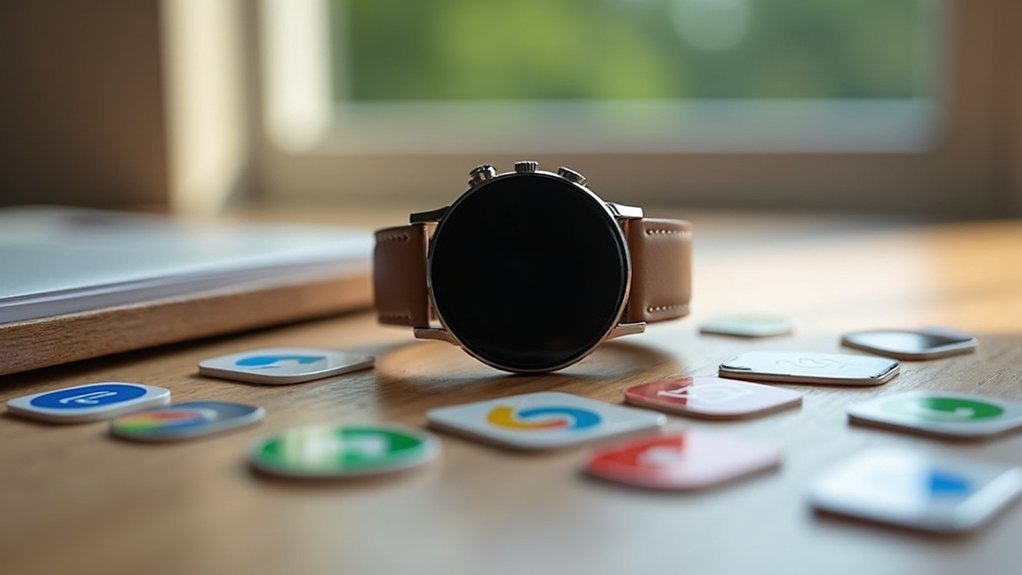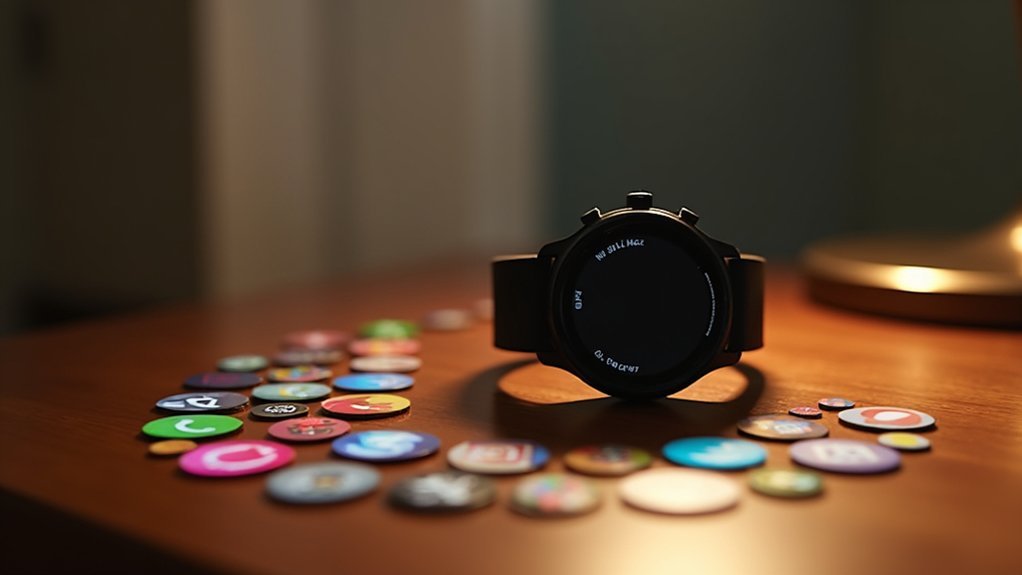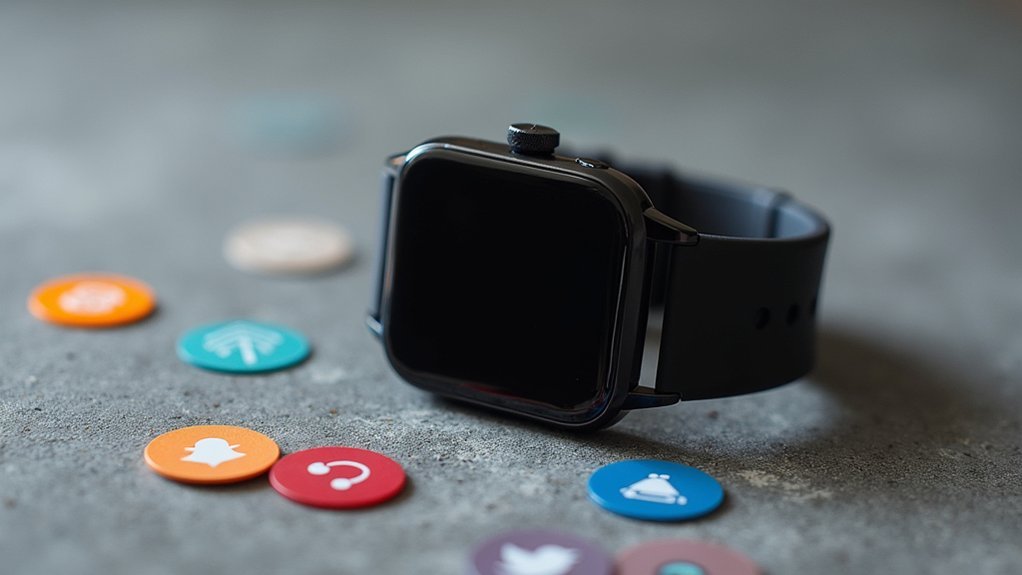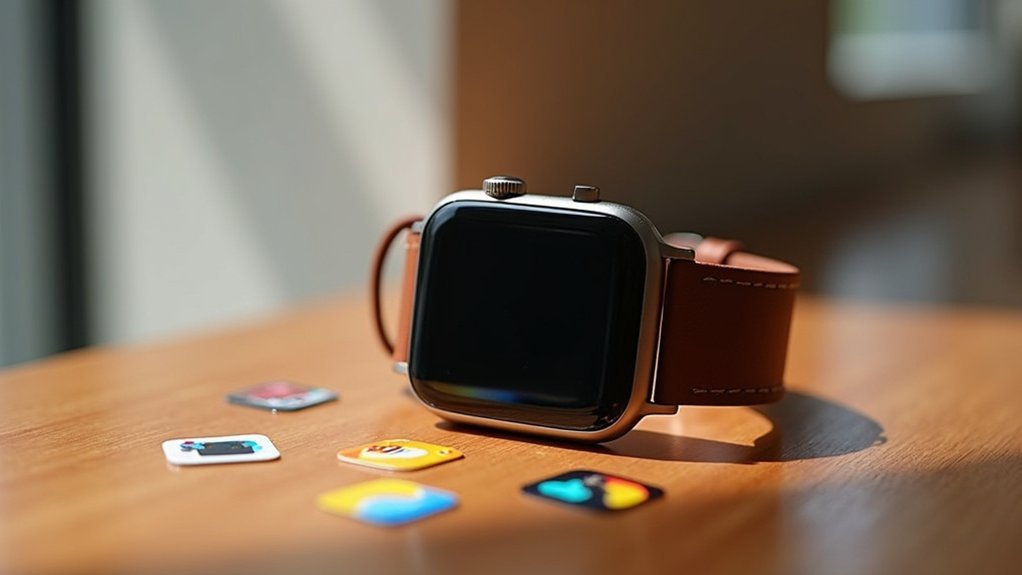You’ll find that watchOS currently offers the best app selection for smartwatches, featuring Apple’s curated App Store with stringent quality standards and extensive developer tools. While Wear OS provides access to approximately 2.06 million apps through Google Play Store integration, watchOS maintains superior developer interest with machine learning-powered app recommendations and seamless ecosystem integration. Samsung Galaxy Watch offers dual app discovery pathways, but Apple’s platform consistently attracts more developers and delivers higher-quality applications. There’s much more to evaluate when choosing your ideal smartwatch platform.
Wear OS App Ecosystem and Google Play Store Integration

When choosing a smartwatch operating system, you’ll find that Wear OS offers unparalleled app selection through its seamless integration with the Google Play Store. You’ll access approximately 2.06 million apps available on the platform, covering fitness, productivity, communication, entertainment, and utilities.
Google’s integration allows automatic syncing between your Android device and Wear OS watch, ensuring continuity across your devices.
You’ll benefit from popular third-party apps like Spotify, Strava, and Google Maps that’ve been optimized for smartwatch use. Developers can easily adapt existing Android apps for Wear OS, expanding your options beyond exclusive smartwatch applications.
The familiar Google Play marketplace makes app discovery and management effortless, while automatic updates keep your apps current without manual intervention. The Wear OS smartwatch market shows strong momentum with a projected 15% CAGR from 2025 to 2033, indicating sustained developer interest and continued app ecosystem expansion.
Watchos App Store Selection for Apple Watch Users
While Wear OS provides extensive app access through Google Play’s vast catalog, Apple Watch users benefit from a more curated but equally robust selection through the dedicated App Store ecosystem.
Apple Watch’s curated App Store delivers quality over quantity, ensuring a more refined experience than Wear OS’s expansive but unfiltered catalog.
You’ll find apps spanning fitness, productivity, utilities, health, and entertainment categories, all meeting Apple’s stringent quality standards through their rigorous review process.
The App Store’s machine learning personalizes recommendations specifically for your interests, while editorial spotlights highlight significant watchOS apps. With 95.37% of iOS apps available for free, you’ll have access to a vast selection of no-cost options alongside premium offerings.
You’ll appreciate the seamless integration with your broader Apple ecosystem—features like Handoff let you shift tasks effortlessly between your watch, iPhone, and other Apple devices.
This curated approach guarantees you’re getting high-quality, reliable apps rather than sifting through potentially buggy alternatives, enhancing your overall user experience.
Garmin Connect IQ Apps and Fitness-Focused Software

If you’re using a Garmin smartwatch, you’ll find the Connect IQ Store offers a robust selection of fitness-focused apps that go beyond basic activity tracking.
The store’s fitness app categories include specialized tools for workout creation, health metrics analysis, and integration with popular platforms like Strava and MyFitnessPal.
What’s driving this extensive app ecosystem is a growing developer community that’s continuously expanding the platform’s capabilities for serious fitness enthusiasts. Users can also download customizable watch faces that adapt to different activities and personal preferences, enhancing both functionality and aesthetic appeal.
Connect IQ Store
Though Garmin’s fitness-focused ecosystem sets it apart from general-purpose smartwatch platforms, the Connect IQ Store serves as the central hub where you’ll find apps specifically designed to enhance your training and outdoor adventures.
You’ll discover over 10 million downloads worth of apps, widgets, and custom watch faces that work seamlessly across Garmin’s device lineup.
The store’s curated selection includes popular integrations like Uber and SmartThings, plus music streaming services that let you control your tunes directly from your wrist.
You can personalize your device with custom data fields and watch faces while managing everything through one centralized platform.
With its 4.8-star Google Play rating and support for both Android and iOS, you’re getting a polished experience that developers regularly update. The developer forum provides community support where developers can collaborate and share solutions to continuously improve the app ecosystem.
Fitness App Categories
Beyond the general app selection, Garmin’s fitness-focused categories form the backbone of what makes Connect IQ truly valuable for serious athletes and fitness enthusiasts.
You’ll find specialized data fields displaying detailed workout metrics like heart rate, power, and cadence with race-day specific parameters. Device apps extend your watch’s functionality to niche activities not supported by default software, while widgets provide glanceable recovery status and training load information.
Key fitness categories include:
- Data Fields – Custom metrics for specific sports and advanced physiological parameters
- Device Apps – Interactive fitness activities expanding default functionality
- Widgets – Quick access to health data and workout notifications
- Watch Faces – Fitness-oriented displays showing relevant workout metrics
- Workout Tools – Real-time guidance and enhanced session tracking
The Connect IQ platform supports diverse activities through applications designed for specialized sports and fitness tracking needs.
Developer Community Growth
While Garmin’s fitness app categories provide the foundation, the thriving developer community behind Connect IQ has transformed the platform into a vast ecosystem with over 10 million downloads as of early 2025.
You’ll find Garmin actively promotes their SDK to attract developers focused on fitness and lifestyle apps, providing extensive documentation and testing tools. The growing third-party app selection enhances your software options considerably.
Community forums foster ongoing developer interaction and idea sharing, while Garmin’s proactive device support additions encourage innovation. The platform offers a user-friendly interface that makes browsing and discovering new applications straightforward for users of all technical levels.
You’ll benefit from this collaborative environment through increasingly sophisticated apps that combine multiple data sources into consolidated displays.
The developer support infrastructure, including security guidelines and feedback loops through user reviews, guarantees you’re getting quality applications that integrate seamlessly with Garmin’s specialized hardware features.
Fitbit OS App Gallery and Third-Party Development

Fitbit’s app ecosystem operates differently from mainstream smartwatch platforms, creating both opportunities and limitations for developers and users alike.
You’ll find the Fitbit OS app gallery exclusively accessible through the mobile app, which restricts discovery to existing device owners rather than attracting new users through web browsing.
The platform’s limitations become apparent when you consider:
- Limited visibility – No web-based store reduces organic search discovery
- Sparse analytics – Developers receive minimal usage feedback or performance metrics
- Narrow focus – Apps primarily center on health and fitness rather than entertainment or productivity
- Restricted variety – Smaller third-party ecosystem compared to WatchOS or Wear OS
- Health integration – Third-party apps must revolve around Fitbit’s core health metrics
This approach prioritizes Fitbit’s health-focused mission while constraining broader app development opportunities. Recent interface improvements demonstrate Fitbit’s commitment to enhancing the native experience for health-focused applications within their ecosystem.
Samsung Galaxy Watch App Marketplace and Developer Support
Unlike Fitbit’s restrictive approach, Samsung’s Galaxy Watch ecosystem offers you dual pathways to app discovery through both the Galaxy Store and Google Play Store integration.
This Wear OS shift greatly expands your app selection beyond Samsung’s native offerings.
You’ll find essential apps like Spotify, which downloads music directly to your watch, and Facer for extensive watch face customization.
The marketplace caters to high user engagement, with 49% of users opening apps 11+ times daily, particularly favoring fitness and lifestyle applications.
Samsung’s developer support stands out with an 80/20 revenue share favoring developers starting May 2025.
Samsung’s generous 80/20 revenue split gives developers a significantly larger share than traditional app store models, boosting platform attractiveness.
Enhanced developer tools, including Galaxy Store Statistics for performance tracking, encourage broader participation. Developers can access detailed financial reports through the integrated seller portal for comprehensive earnings analysis.
This developer-friendly approach promises more diverse app offerings as the expanding community creates specialized smartwatch applications.
OnePlus Watch App Availability and Performance Optimization
The OnePlus Watch 3 takes a different approach to app availability by supporting direct Google Play browsing and syncing, expanding your access beyond the platform’s native offerings.
You’ll find popular apps like Strava, Spotify, AllTrails, and Audible running smoothly on the device, though the selection remains limited compared to Wear OS or watchOS ecosystems.
The watch delivers impressive performance optimization through:
- Buttery-smooth AMOLED display with rotating digital crown for fluid navigation
- Exceptional 120-hour battery life maintaining efficiency during active app usage
- All-in-one sensor integration enabling accurate heart rate monitoring and ECG functionality
- Dual-frequency GPS supporting real-time performance in fitness applications
- Regular OTA updates providing ongoing performance enhancements
While you’ll appreciate the responsive hardware and growing third-party support, the app marketplace isn’t as mature as established platforms. The watch’s Dual-Engine Architecture with Snapdragon W5 and BES 2800 chipsets ensures optimal power efficiency when running multiple applications simultaneously.
Cross-Platform App Compatibility Between Operating Systems
When you’re switching between smartwatch platforms, you’ll quickly discover that your favorite apps rarely follow you to the new ecosystem.
Most developers can’t justify the resources needed to maintain versions across watchOS, Wear OS, Tizen, and other platforms, leaving you with fragmented app availability.
You’ll need to completely rebuild your app collection and workflow when migrating from one smartwatch operating system to another. Wear OS provides access to the Play Store, offering the broadest selection of available applications compared to other platforms.
App Migration Challenges
Although smartwatch operating systems share similar core functionalities, migrating apps between platforms presents significant technical hurdles that developers can’t simply overcome through basic code adjustments.
You’ll face substantial challenges when attempting cross-platform app migration:
- Architecture incompatibility – watchOS uses Swift/SwiftUI, Wear OS relies on Kotlin/Java, and Tizen requires C/C++ rewriting.
- Development environment restrictions – Each platform demands distinct SDKs: Xcode, Android Studio, and Tizen Studio respectively.
- UI paradigm differences – Digital Crown interactions, card-based interfaces, and rotating bezels require complete UX redesigns.
- Hardware-specific limitations – Varying sensor APIs and performance profiles necessitate platform-specific optimizations.
- Ecosystem constraints – Proprietary APIs and app store restrictions prevent seamless cross-platform deployment.
These technical barriers mean you’re fundamentally rebuilding apps rather than migrating them. The app ecosystem directly determines which applications will be available to users on their chosen platform.
Developer Multi-Platform Strategy
Most developers pursuing smartwatch app success must embrace a multi-platform strategy that acknowledges fundamental incompatibilities between operating systems. You’ll need to maintain separate codebases since Wear OS requires Android Studio with Java or Kotlin, while watchOS demands Xcode with Swift.
| Platform | Development Requirements |
|---|---|
| Wear OS | Android Studio, Java/Kotlin, Round UI adaptation |
| watchOS | Xcode, Swift, Square/rectangular UI design |
Cross-platform frameworks exist but require extensive customization for each OS. You’ll face design challenges adapting between round Wear OS displays and Apple Watch’s rectangular screens. Feature parity remains difficult since streaming capabilities, offline functionality, and app approval processes differ considerably. While both platforms offer robust emulators and active developer communities, you can’t simply port apps between ecosystems without substantial modifications.
The competitive landscape shows that app quality varies significantly between platforms, with watchOS and WearOS maintaining higher standards than emerging alternatives.
Popular Third-Party Apps Available Across Different Platforms
While each smartwatch platform maintains its own app ecosystem, several popular third-party applications have successfully bridged the gap between operating systems to serve users across different devices.
You’ll find these essential apps available across multiple smartwatch platforms:
- Spotify – Stream music directly from your watch on both Wear OS and watchOS
- Strava – Track fitness activities with optimization for WearOS and full watchOS compatibility
- Google Fit – Monitor health metrics on Wear OS and other Android smartwatches
- Lifesum – Access dietary guidance across various smartwatch platforms
- Cardiogram – Monitor heart rate on both Android and iOS devices
This cross-platform availability means you won’t lose access to your favorite apps when switching between different smartwatch ecosystems, giving you flexibility in choosing your preferred device. However, Apple Watch users have access to the most extensive third-party app library due to the platform’s mature ecosystem and developer support.
Developer Tools and SDK Support for Each Operating System
Behind every successful smartwatch app lies a robust development framework that enables programmers to harness each platform’s unique capabilities. You’ll find Wear OS SDK leverages Android Studio’s extensive toolset, featuring Jetpack Compose for responsive UI design and specialized templates for wearable development. Apple’s watchOS SDK integrates seamlessly with Xcode, offering SwiftUI frameworks and powerful HealthKit APIs for advanced health applications.
| Platform | Key Development Tools | Standout Features |
|---|---|---|
| Wear OS | Android Studio, Jetpack Compose | Cross-device compatibility testing, microinteraction optimization |
| watchOS | Xcode IDE, SwiftUI | Seamless ecosystem integration, rich complications support |
| Tizen OS | Tizen Studio, Samsung Mobile SDK | Rotating bezel navigation, open-source customization |
Samsung’s Tizen Studio provides unique rotating bezel APIs, while IoT-focused SDKs offer low-level hardware access for specialized applications. These development ecosystems directly impact app quality and availability. However, watchOS maintains the most successful position in the market with its comprehensive app ecosystem and developer-friendly tools.
Future App Development Trends for Smartwatch Platforms
As smartwatch platforms mature, developers are embracing transformative technologies that’ll reshape how you interact with wearable devices.
You’ll witness a fundamental shift toward intelligent, personalized experiences that adapt to your unique patterns and preferences.
The most significant trends include:
- AI-driven personalization that creates hyper-customized fitness routines and productivity schedules based on your behavioral data
- Advanced health monitoring with non-invasive sensors tracking blood oxygen, glucose levels, and mental health indicators
- Augmented reality integration delivering contextual overlays for navigation, exercise guidance, and immersive entertainment
- Cross-platform functionality ensuring seamless data synchronization across all your connected devices
- Enhanced wearable payments featuring biometric authentication and cryptocurrency wallet integration
These innovations position smartwatches as essential tools for health management, productivity, and commerce. Development complexity significantly impacts project timelines, with basic wearable apps requiring 3-6 months while advanced features may extend development cycles considerably.
Frequently Asked Questions
Can I Sideload Apps on Smartwatches Without Using Official App Stores?
You can sideload apps on some smartwatches, but it’s technically challenging and risky. Wear OS allows sideloading through developer tools, while Tizen has restrictions and watchOS blocks it entirely.
Which Smartwatch OS Has the Fastest App Loading and Execution Times?
You’ll find watchOS traditionally delivers faster app loading times due to optimized hardware-software integration. However, Wear OS has considerably improved with powerful Snapdragon chips, nearly matching watchOS’s performance and responsiveness.
Do Smartwatch Apps Work Offline or Require Constant Internet Connectivity?
You’ll find smartwatch apps work with mixed connectivity requirements. Most apps cache data locally, enabling basic offline functionality, but you’ll need internet connectivity for full features like syncing, updates, and real-time information access.
How Much Storage Space Do Smartwatch Apps Typically Consume?
You’ll find smartwatch apps consume varying storage space depending on complexity. Basic notification apps use 1-5 MB, fitness apps need 10-50 MB, music streaming requires 20-100 MB, while games typically consume 10-50 MB of storage.
Can Smartwatch Apps Access and Control Other Connected Iot Devices?
Yes, you can control IoT devices through smartwatch apps. Wear OS enables smart home system control, including lights and thermostats. Voice assistants like Google Assistant help you manage various connected devices seamlessly.
In Summary
You’ll find Apple’s watchOS delivers the strongest app selection with its mature App Store ecosystem and extensive developer support. If you’re deeply invested in fitness tracking, Garmin’s Connect IQ offers specialized apps that’ll meet your athletic needs. Wear OS provides decent Google integration, while Samsung’s growing marketplace shows promise. However, you can’t beat Apple’s combination of quantity, quality, and seamless integration across third-party apps and native functionality.





Leave a Reply